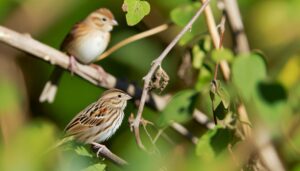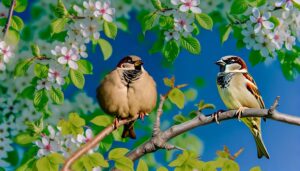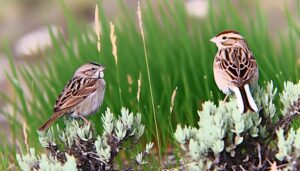Finch Bird vs Sparrow – 5 Key Differences You Should Know
Finches and sparrows, often mistaken for one another, show distinct differences. Finches have vibrant plumage and stout beaks designed for seed-crushing, while sparrows exhibit more subdued coloration and slender beaks adaptable to varied diets.
Finches weigh 10-20 grams and measure 10-20 centimeters, contrasting sparrows' larger 24-40 grams and 14-18 centimeters. Finches sing complex songs, unlike the simpler calls of sparrows.
Habitat preferences diverge, with finches favoring wooded rural areas and sparrows thriving in urban environments. Their social behaviors and nesting habits also highlight their unique ecological adaptations.
For a deeper exploration into these fascinating avian distinctions, continue onward.
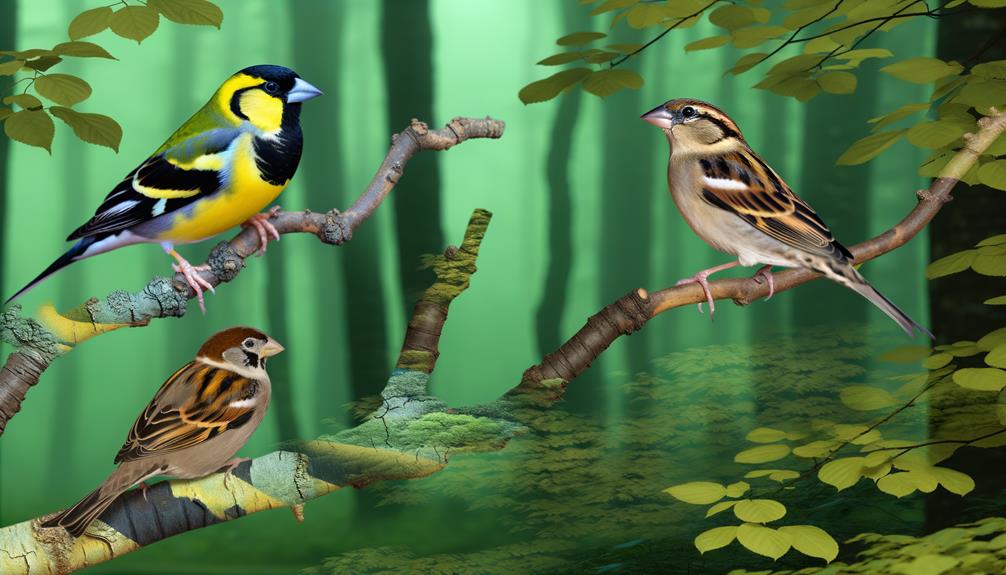
Key Takeaways
- Finches exhibit more vibrant and varied plumage, while sparrows have consistent, earthy tones.
- Sparrows are generally heavier and slightly larger than finches.
- Finches have shorter, stouter beaks for seed-crushing; sparrows have longer, slender beaks for a varied diet.
- Finches prefer rural, wooded areas, whereas sparrows thrive in urban environments.
- Finch songs are complex and melodious; sparrow calls are simpler and repetitive.
Physical Appearance
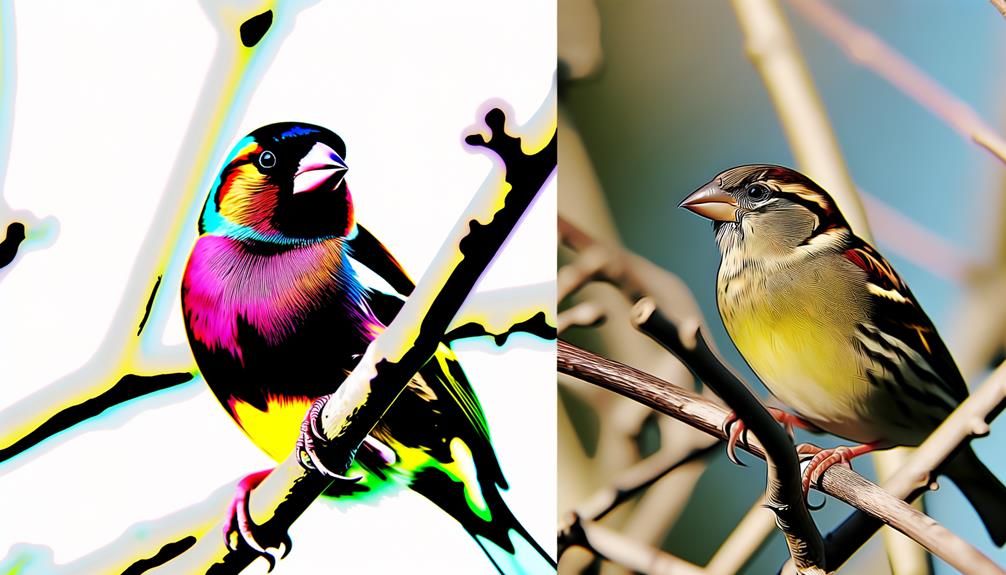
Although both finches and sparrows exhibit small, compact bodies, finches often display more vivid plumage and distinctive color patterns compared to the generally more subdued and earthy tones of sparrows. Observational data indicate that finches possess a broader spectrum of colors, including bright reds, yellows, and blues, which are used in mating displays and territorial behaviors.
Sparrows, in contrast, exhibit more cryptic coloration, blending into their environments with shades of brown, gray, and white. This camouflage aids in predator avoidance. Detailed analysis reveals that finch plumage can vary significantly between species, while sparrow species show less variation in color.
Both birds use their plumage for temperature regulation, but their coloration strategies differ markedly due to ecological adaptations.
Size and Weight
Finches typically exhibit a more diverse range of sizes compared to sparrows, with adult finches weighing between 10 to 20 grams and measuring around 10 to 20 centimeters in length.
Sparrows, on the other hand, tend to be more uniform, generally weighing between 24 to 40 grams and measuring approximately 14 to 18 centimeters. Observational data reveal finches' size diversity aligns with their varied habitats and ecological niches.
This size variance allows finches to exploit a broader range of food sources and nesting sites. Sparrows, with their more consistent size range, are highly adaptable to urban environments.
Both species display evolutionary adaptations that secure their survival, although finches' size variability provides a slight edge in diverse ecosystems.
Beak Differences

The beaks of finches and sparrows exhibit distinct morphological differences, with finches generally possessing shorter, stouter beaks adapted for seed-crushing, while sparrows have longer, more slender beaks suited for a varied diet that includes both seeds and insects. Observational data indicate that finch beaks are robust, facilitating the breaking of hard seeds. In contrast, sparrow beaks are more versatile, allowing them to forage for insects and softer plant matter efficiently. These adaptations reflect their ecological niches and dietary requirements.
| Feature | Finches | Sparrows |
|---|---|---|
| Beak Length | Short | Long |
| Beak Shape | Stout | Slender |
| Primary Diet | Seeds | Seeds and Insects |
| Adaptation | Seed-crushing | Versatile foraging |
| Ecological Role | Specialized seed eaters | Generalist feeders |
These beak differences highlight their evolutionary adaptations to specific environments.
Color Patterns
Finches exhibit a more vibrant and varied plumage compared to sparrows, which typically show more muted browns and grays. Observational data highlight that finches often display striking reds, yellows, and greens, while sparrows maintain consistent, earthy tones throughout the year.
Seasonal color changes are also more pronounced in finches, as males often develop brighter, more conspicuous colors during the breeding season.
Plumage Color Differences
In examining the plumage color differences, one observes that finches often exhibit more vibrant and varied color patterns compared to the generally muted tones of sparrows. Finches, such as the Gouldian Finch, display an array of colors including reds, greens, and yellows, resulting from carotenoid pigments. Their plumage serves both in mate attraction and territorial displays.
Conversely, sparrows, particularly the House Sparrow, exhibit more subdued hues ranging from browns to grays, often with streaked patterns. These cryptic colors provide excellent camouflage against predators in their terrestrial habitats.
Detailed ornithological studies have highlighted that the finches' colorful plumage is a result of both genetic factors and diet, whereas sparrows' more drab appearance aligns with their evolutionary ecological niches.
Seasonal Color Changes
While finches and sparrows exhibit distinct plumage colors, observing their seasonal color changes reveals further fascinating adaptations.
Finches undergo significant molts; males often shift from dull, non-breeding colors to vibrant hues, enhancing reproductive success. For example, the American Goldfinch shifts from olive-brown in winter to bright yellow in summer.
Conversely, sparrows exhibit more subtle seasonal changes. The White-throated Sparrow's breeding plumage intensifies slightly, with a more pronounced white throat and yellow lores.
These changes, driven by hormonal shifts and environmental cues, underscore each species' survival strategies.
Detailed field observations and banding studies confirm these patterns, illustrating how seasonal color changes enhance camouflage, mating prospects, and species-specific roles within their ecosystems.
Song and Calls

Understanding the distinctions in song and calls between finches and sparrows reveals critical insights into their communication behaviors and ecological adaptations.
Finches typically exhibit a more complex and melodious song structure, often utilizing a series of varied notes and intricate patterns. In contrast, sparrows generally produce simpler, repetitive calls which may serve to establish territory or attract mates.
Observational data indicates:
- Finch songs: Longer and more varied, indicating advanced vocal learning.
- Sparrow calls: Shorter and repetitive, suggesting innate vocalization.
- Ecological adaptation: Finch songs can penetrate dense foliage, aiding in communication in forested areas.
- Behavioral roles: Sparrow calls may function more in ground-level communication, aligning with their terrestrial habits.
This divergence highlights the evolutionary strategies each species employs for survival and reproduction.
Feeding Habits
Finches primarily consume seeds, while sparrows exhibit a more varied diet that includes seeds, insects, and small invertebrates.
Observational data indicate that finches feed more frequently than sparrows, especially during the breeding season.
Seasonal shifts in food availability lead both birds to adjust their diets, with sparrows increasing insect consumption in warmer months.
Common Food Sources
Both finches and sparrows exhibit distinct feeding habits. Finches primarily consume seeds and nuts, while sparrows also incorporate insects and small invertebrates into their diet. Observations reveal that finches possess strong beaks adapted for cracking open hard seed coats, while sparrows demonstrate versatility by foraging for various food sources on the ground.
Their dietary preferences reflect their ecological niches and contribute to their survival strategies.
Key food sources include:
- Finches:
- Seeds from grasses and trees
- Sunflower seeds
- Nuts
- Sparrows:
- Seeds and grains
- Small insects (e.g., beetles, caterpillars)
- Spiders and other invertebrates
Such dietary distinctions underscore the adaptive evolution of their feeding mechanisms, ensuring both species can thrive in diverse environments.
Feeding Frequency Comparison
Observational data indicates that sparrows exhibit more frequent feeding intervals compared to finches, likely due to their higher metabolic rates and diverse diet. Studies show sparrows feed approximately every 10-15 minutes throughout daylight hours, consuming seeds, insects, and grains. Their rapid metabolism necessitates constant energy intake.
In contrast, finches demonstrate less frequent feeding behavior, often feeding every 20-30 minutes. Finches primarily consume seeds, which are energy-dense and require less frequent consumption. The disparity in feeding frequency suggests a correlation between metabolic demands and dietary preferences.
Sparrows' varied diet supports their active foraging behavior, while finches' specialized seed consumption enables longer intervals between meals. This feeding frequency difference highlights the adaptive strategies each species employs for survival.
Seasonal Diet Changes
Throughout the year, sparrows and finches adjust their diets based on seasonal availability of food sources, reflecting their adaptive foraging strategies. These changes ensure optimal nutrition and survival. In spring and summer, both species prioritize insect consumption for protein, aiding in breeding and chick development.
During fall and winter, they shift focus to seeds and grains, which are more abundant and energy-dense. Observational data highlights:
- Sparrows: Favoring grass seeds and agricultural grains in colder months.
- Finches: Preferring thistle and sunflower seeds when insects are scarce.
- Both Species: Utilizing bird feeders, especially during harsh weather conditions.
- Seasonal Variation: Influencing migration patterns and habitat use.
Their dietary versatility showcases their resilience and adaptability in fluctuating environments.
Nesting Behavior
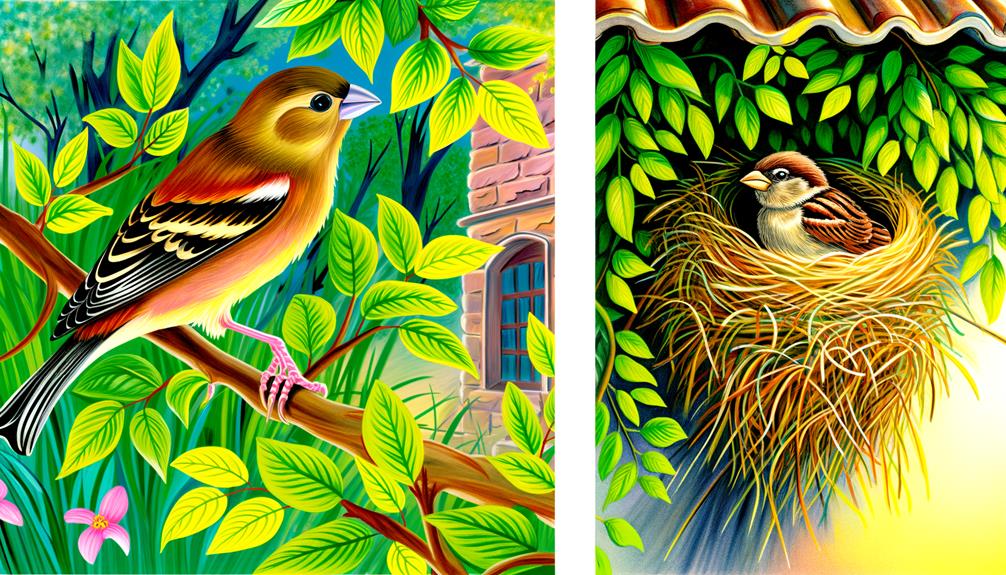
While finches meticulously weave intricate nests in trees and shrubs, sparrows often prefer the simplicity of constructing their nests in open cavities or dense foliage. Finch nests, composed of twigs, grasses, and spider silk, display a high degree of craftsmanship, reflecting their adaptive behavior to predation and environmental challenges. Observational data indicate that finches invest significant time and effort into selecting secure locations and materials, optimizing for camouflage and stability.
Conversely, sparrows exhibit a more opportunistic nesting strategy. They frequently utilize existing structures such as birdhouses or crevices, minimizing construction time. This behavior, coupled with their lesser emphasis on material selection, suggests an evolutionary strategy prioritizing rapid reproduction and adaptability.
Both species' nesting behaviors reveal distinct evolutionary adaptations to their ecological niches.
Preferred Habitats
Finches and sparrows exhibit distinct habitat preferences. Finches favor rural settings, while sparrows thrive in urban environments. Observational data indicate finches frequently nest in wooded areas, whereas sparrows often construct nests in man-made structures.
These preferences highlight the species' adaptability to varying ecological niches and human activity levels.
Urban Vs. Rural Settings
Sparrows and finches exhibit distinct preferences for their habitats, with sparrows often thriving in urban environments while finches tend to favor rural or less populated areas. Sparrows' adaptability to human-altered landscapes allows them to exploit resources like food scraps and nesting sites on buildings.
Conversely, finches are more commonly found in rural settings, where open fields and abundant vegetation provide ideal conditions for foraging and shelter.
- Sparrows' urban adaptation: thriving amidst human activity.
- Finches' rural preference: flourishing in natural, less disturbed environments.
Resource availability is a critical factor influencing habitat choice, with sparrows and finches showing a clear distinction in their preferences based on the resources present in urban and rural environments.
- Resource availability: a critical factor influencing habitat choice.
Predator pressures also vary significantly between urban and rural settings, further shaping the habitat preferences of sparrows and finches.
- Predator pressures: varying significantly between urban and rural settings.
This habitat divergence underscores each species' unique ecological niche, shaped by evolutionary pressures and environmental variables.
Nesting Preferences
Observational data reveals distinct nesting preferences between sparrows and finches, highlighting their unique adaptations to urban and rural habitats, respectively. Sparrows exhibit a proclivity for urban environments, frequently nesting in man-made structures like eaves, gutters, and streetlights. This behavior underscores their adaptability to bustling cityscapes.
Conversely, finches prefer rural settings, selecting trees and shrubs to construct their nests, often favoring areas with dense foliage for protection. Finches' nests are intricately woven, showcasing their meticulous nature.
The choice of nesting sites by both species indicates significant behavioral adaptations driven by environmental pressures. Such preferences underscore their evolutionary strategies to maximize survival and reproductive success in their respective habitats, whether amidst urban sprawl or serene countryside.
Geographic Distribution

Across various continents, both finches and sparrows exhibit distinct geographic distributions influenced by climate, habitat availability, and migratory patterns.
Finches are predominantly found in the Americas, particularly in temperate and tropical regions, while some species are native to the Galápagos Islands, showcasing remarkable adaptive radiation.
Sparrows, on the other hand, display a more cosmopolitan distribution, inhabiting diverse ecosystems from urban areas to grasslands across Europe, Asia, Africa, and the Americas.
Climate Adaptability: Finches often thrive in warmer climates, whereas sparrows can endure a broader range of temperatures.
Habitat Specificity: Finches prefer forested or bushy areas; sparrows adapt well to human-altered environments.
Migration Patterns: Many sparrow species exhibit long migratory journeys; finch migration is less extensive.
Invasive Species: House Sparrows have established populations worldwide.
Social Behavior
Both finches and sparrows display complex social behaviors that are influenced by their respective environmental contexts and evolutionary histories.
Finches, particularly in flock settings, exhibit cooperative behaviors like communal roosting and synchronized foraging, which enhance survival through collective vigilance. Observational data show sparrows, especially house sparrows, engage in hierarchical social structures where dominant individuals secure superior nesting sites and food resources. These dynamics often result in intense intraspecific competition.
Additionally, sparrows' vocal communications play an important role in territory defense and mate attraction. In contrast, finches' social interactions are marked by intricate song patterns that facilitate mate selection and reinforce social bonds.
These behaviors highlight the adaptive strategies that both species employ to thrive in their habitats.
Conclusion
Simply put, finches and sparrows show remarkable distinctions across various traits.
Finches frequently showcase vivid color patterns and robust beaks, whereas sparrows typically have more subtle shades and slender beaks.
Their songs and calls differ noticeably, as do their nesting behaviors and favored habitats.
Socially, both birds exhibit distinct interactions within their surroundings.
Grasping these differences offers a better understanding of the ecological roles each species fulfills across their varied geographic ranges.


